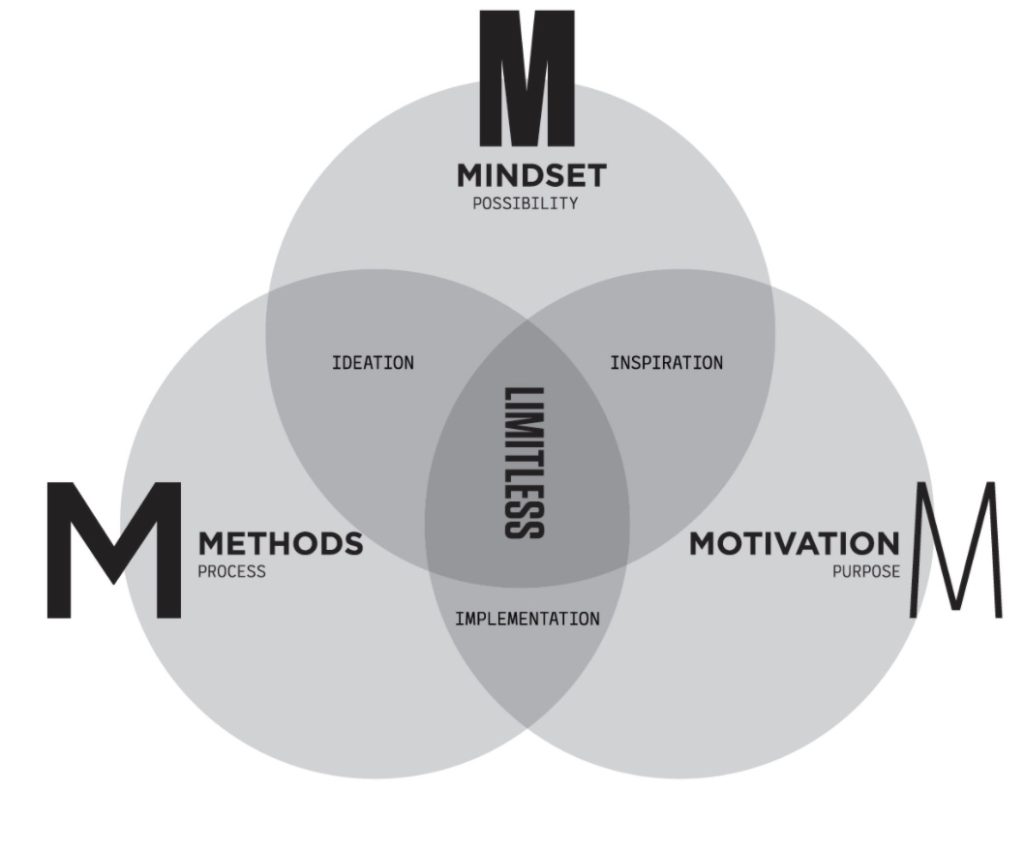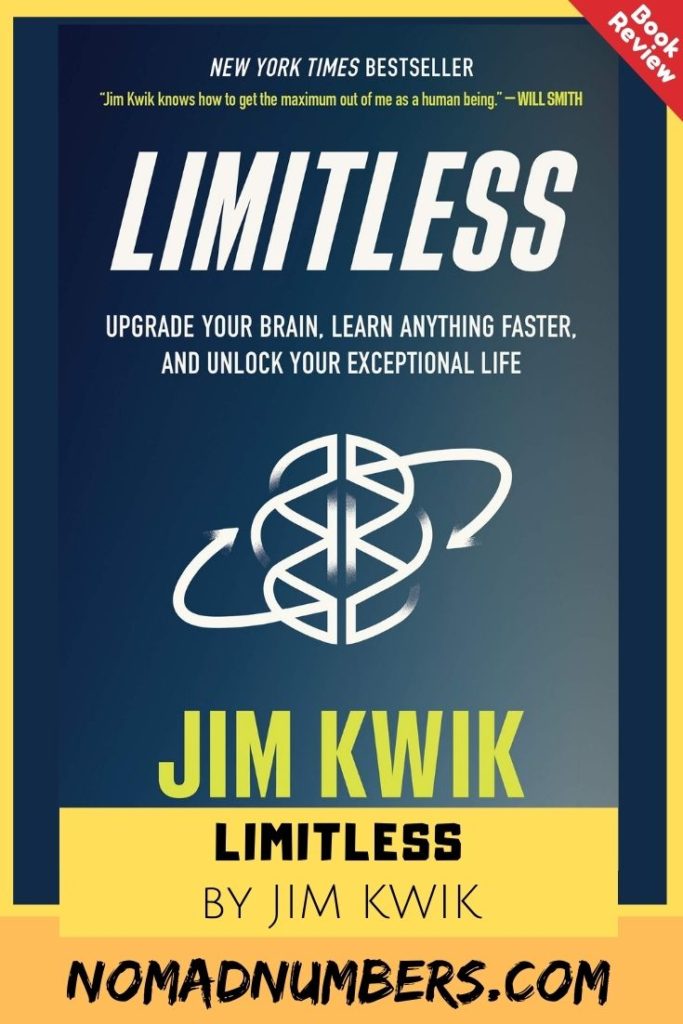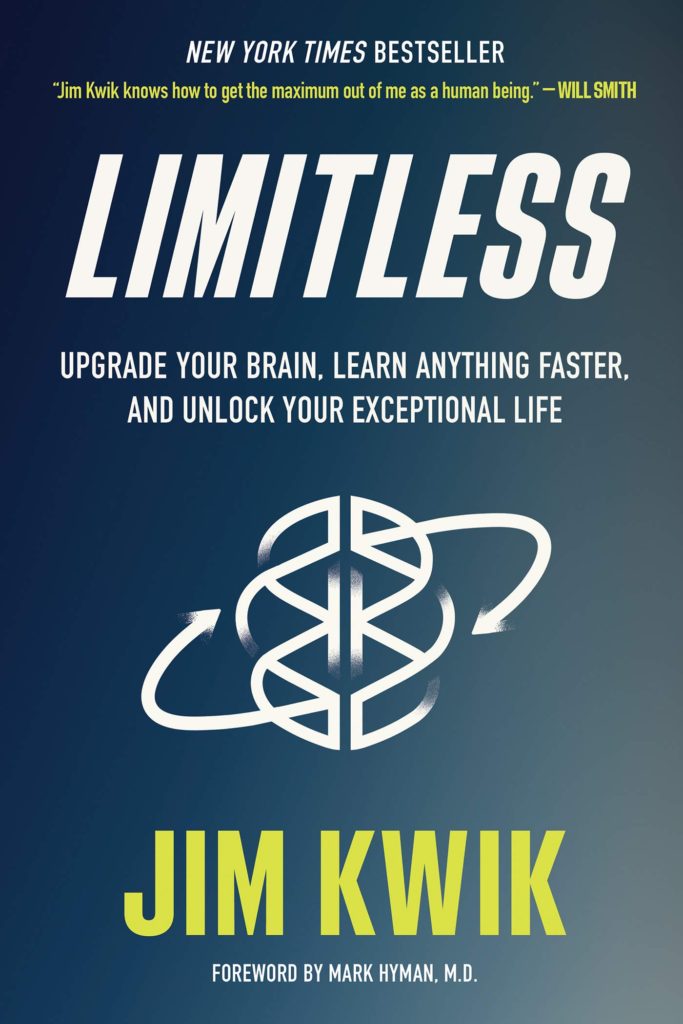It is time for another book review! Today we will do a book review of Limitless by Jim Kwik which makes bold claims like “upgrading your brain”, “learning anything faster” and “unlocking [an] exceptional life”.
“If knowledge is power, then learning is a superpower”
JIM KWIK
In this article I will be going giving a book review of Limitless: Upgrade Your Brain, Learn Anything Faster, and Unlock Your Exceptional Life by Jim Kwik. I will explain why I decided to read this book, what the book is about, give you a high-level summary, share my takeaways from it as well as the specific action items I plan to implement after reading it (that last part is probably the most important part of reading any self-improvement book).
So, without further ado, let’s dig into my book review of Limitless by Jim Kwik!
Some links to the products mentioned below are affiliate links, meaning that if you click and make a purchase, we (Nomad Numbers) may receive a commission at no additional cost to you. For more information please review our disclaimer page.
Why Limitless?
We are on a lifelong journey of growth, especially in the area of health and mind. So we are constantly consuming a lot of content on how to improve these areas of our life. I found about this book when Mrs. NN mentioned Jim Kwik (his real name!) to me after she started listening to his podcast: Kwik Brain. I decided to start reading it as a follow-up to another personal development book I read earlier this year: Super Human: The Bulletproof Plan to Age Backward and Maybe Even Live Forever (read my book review here).
Book summary of Limitless by Jim Kwik
What is the book about?
In a nutshell, Limitless is a book divided into three parts: Mindset, Motivation, and Methods and for each of these parts, the author will provide ways to remove limitations associated with each of them so you can become literally Limitless! Let’s go through the content of the book.
Part I – Free Your Mind
In this first part, Jim covers his personal life as a child and explains the handicap he had after experiencing a brain injury that made it very difficult for him to learn and retain information while it was actually a limitation he put on himself and that we also put on ourselves.
He offers his Limitless Model to remove any limitations you might have about yourself. The Limitless Model is made of a three-part framework: Mindset (the what), Motivation (the why), and Method (the how).

Before digging into his framework, Jim talks about the four supervillains of learning:
- Digital Deluge: the amount of information we have access to and how much we consume per day, pulling us away from meaningful work/activities
- Digital Distraction: the negative effect of being always connected and especially getting distracted with notifications on our devices (phone, tablet, laptops)
- Digital Dementia: the fact that we rely on our devices to remember everything (from phone numbers to directions) which reduces how much you need to use our brain for
- Digital Deduction: making decisions by relying on Internet sources or opinion rather than our own
Jim then explains the power of our brain and how it can grow and expand the more we use it, creating new connections as we need to retain more information during our entire life. He also digs into our second brain (aka our gut) and how the two are interconnected and what we feed ourselves might matter as much as the work to acquire new knowledge.
He closes this section by providing the FASTER method to absorb quickly any content you consume. FASTER stands for Forget, Act, State, Teach, Enter, and Review.
Some action-items from Jim to Free Your Mind:
- Schedule 30 minutes of white space in your calendar for this week to be away from technology and use this time to relax and be creative instead
- Go to the notification settings of your phone and turn off everything unnecessary.
- Take a minute to exercise your memory by memorizing the phone number of someone you communicate with regularly
- Think about a decision you need to make. Schedule some time to work on that decision without the use of any digital devices
- Identify which of the 4 digital villains is most disrupting your performance
Part II – Limitless Mindset (What)
In this section, the author focuses on the Mindset (the what) related to learning and demystifies some limiting beliefs we have about it so we can both understand what they are and how to overcome them.
Jim then goes on to share the 7 lies of learning that we tell ourselves:
- Lie #1: Intelligence is fixed – Not true, intelligence is fluid.
- Lie #2: We only use 10% of our brains – Not true, we should learn to use our whole brain in the best way possible.
- Lie #3: Mistakes are failures – Not true, there are no such things as failure, only failure to learn.
- Lie #4: Knowledge is power – Not true, knowledge is not power. It only has the potential to be power. (Knowledge x Action = Power)
- Lie #5: Learning new things is very difficult – Not true, when you learn new ways how to learn, the challenge of learning new things can be fun, easier, and more enjoyable.
- Lie #6: The criticism of other people matters – Not true, what matters is how you live, and taking criticism from others can only lead to having them run or ruin your life. It is your own job to like, love, or respect yourself, not someone else.
- Lie #7: Genius is born – Not true, genius is made through deep practice.
“Knowledge is not power. It only has the potential to be power.”
JIM KWIK
Some action-items from Jim Kwik about Mindset:
- When you are about to read, set a timer for 25 minutes and concentrate on what you are reading in the book for that amount of time. When the alarm goes off, bookmark the book and close it then write down what you learned within that 25 minute period.
- When reading and your mind wanders, keep a notebook close by to capture these thoughts or ideas by writing them down so they can be released temporarily from your mind.
- Before each reading, take a few minutes to talk/write about what you remember from your previous reading session
- How many of the 7 lies of learning do you believe in?
Part III – Limitless Motivation (Why)
In this part of the book, Jim covers Motivation (the why) and explains that motivation is “purpose” times “energy” times “small simple steps”. When you combine all of these ingredients you get to sustainable motivation.
“Motivation is a set of habits and routines, guided by your values and your identity that you carry out every day.”
JIM KWIK
Jim starts by defining our Purpose and provide a few useful definitions:
- Our identity: It is who we are. It usually starts with “I am…”.
- Our purpose: It is what gets you up in the morning and how we relate to other people. It is how we use our passions. – Example: “to teach other people to learn”
- Our passions: They are what bring us joy and they are something we find through discovery and experimentation. – Example: learning
- Our values: it is a prioritized list of what is most important in our lives (they usually don’t change over time) – Example: “love, growth, contribution and adventure”, in that order
- Our reasons: it is what keeps us motivated and supports our passion, identity, and values. They are expressed using the format “I want to… so that…” – Example: “I want to learn to remember names so that I can better connect with people in my community and help foster a stronger network of people I care about.”
He then moves to defines Energy and provides his top 10 recommendations for generating limitless brainpower:
- A good brain diet (Avocadoes, Blueberries, Broccoli, Dark chocolate, Eggs, Green leafy vegetables, Salmon/Sardines/Caviar, Turmeric, Walnuts, and Water).
- Brain nutrients
- Exercise
- Killing ANTs (Automatic Negative Thoughts)
- A clean environment – Air, water…
- A positive peer group – We are the average of the 5 people we spend the most time with
- Brain protection – Protect your head from injuries
- New Learning – Always learn something new
- Stress Management – Stress will kill you
- Sleep – Sleep is key to consolidate your memory and learning from the day
Jim then explains how to take small simple steps by:
- breaking down bigger tasks into smaller ones that can be easily completed to give us a constant sense of achievement and progress
- creating new habits (using the habit loop: cue, craving, response, reward) using small increments and building on your progress over time
- building a morning routine to jump-start your day.
He also shares his morning routine:
- Recording your dream as you wake up – To look for new ideas or new perception
- Making the bed – An easy win to start the day
- Drinking a tall glass of water – To hydrate the body and the brain
- Brushing your teeth with the opposite hand – To stimulate the brain
- Doing a three minutes workout – To raise the heart rate and increase oxygenation of the brain
- Taking a cold shower – To reset the nervous system and manage inflammation
- Breathing exercise – To fully oxygenate the body
- Drinking a “brain tea“
- Drinking a “brain smoothie”
He wrapped up this section of the book by talking about flow, how to get into it (by eliminating distraction, giving yourself enough time, doing something you love, having clear goals, challenging yourself), and what are the major enemies of flow (multitasking, stress, fear of failure, lack of conviction).
Some action-items from Jim Kwik about Motivation:
- Do you know your life’s purpose? Write down what it could be
- Take 60 seconds and write down “I am…” statement to figure out your identity
- Set your phone alarm to remind yourself to move for a few minutes every hour
- What is your biggest ANT? What could you replace it with?
- What is one thing you can do today to clean your environment?
- Who is someone you need to spend more time with? Reach out and make a date with that person now!
- Create an ongoing “To Learn” list. Start populating it.
- What are your favorite things to do to cope with stress? When was the last time you did it?
- Think about an important task you’ve been putting off. What is it? How can you break it down into simpler steps that you can do each day?
- Can you identify the habits you want to break? What is that one habit that’s holding you back from doing other important things in your day?
- Create your new morning routine. What are 3 things you will always do when you first wake up to set up your day to win?
- Have you ever experienced the flow state? Where were you? What were you doing? How did it feel? What did you achieve at the end of it? Visualize that state.
Part IV – Limitless Methods (How)
This section covers Methods (the how) to learn the science of accelerated learning and meta-learning in five areas: focus, study, memory, speed reading, and thinking.
For the focus, Jim suggests looking at our to-do list for the day and identify what can disrupt us, and offers anti procrastination tools to address such items. Then we should declutter our environment so we aren’t distracted by unnecessary stimuli (like notifications, too many apps open on our laptop, pictures of our loved one standing on our desks, and so on). Last but not least practicing techniques to calm our busy mind (like meditation or yoga).
For the study, Jim provides seven simple habits to help us absorb any content more efficiently:
- Employ active recall – Review the material then immediately check how much you remember
- Employed spaces repetitions – Review the material at similar interval
- Manage the state you are In – How motivated are you? Make sure you have a good posture (sit straight)
- Use your sense of smell – Smells are effective at bringing back memory so use an essential oil on your wrist when studying/reading and again during a test/meeting
- Music for the mind – Baroque music creates an atmosphere of focus
- Listen with your whole brain – Use HEAR (Halt – be completely present and remove all distraction, Empathy – imagine yourself in the speaker shoes, Anticipate – engage in the experience with a sense of anticipation, Review – engage with the speaker, ask clarifying questions)
- Take note of taking notes – Use TIP (Think – what are you hoping to retain from the material/session?, Identify – Identify what is most important, Prioritize – review your notes and highlight what is most important after the session).
For the memory, always remember MOM:
- Motivation – what motivates you to remember something?
- Observation – pay attention to what you want to remember
- Methods – use tools to help you remember).
Most people approach learning as a passive activity, however, Jim suggests to take an active approach and focus on the following:
- Visualization: paint a picture of what you would like to remember.
- Association: associate the information with something you already know
- Emotion: add emotion (make the memory humorous, action-filled) to make it last
- Location: associate a memory with a location you are more likely to remember it
He then provides various exercises to practice these. Like using a common location you know well and putting these 10 words you want to remember. Then use Emotion to Visualize these words and Associate them with each item in that location. For instance, if you think about your kitchen, you can place items on the table, kitchen, gas stove and so on…
To remember people’s name use BE SUAVE
- Believe – Believe that you can remember
- Exercise – Like with every tool, practice makes progress
- Say It – When you hear someone’s name for the first time, say it back to confirm you hear it correctly
- Use It – During the conversation, use the person’s name
- Ask – Ask where a person’s name comes from
- Visualization – Try to attach an image to the person’s name
- End – End your conversation by saying the person’s name
For speed reading, Jim suggests reading a book like watching a movie. In other words, instead of being slowed down by subvocalization (the voice inside our head when we read) and reading every single word we should expand our peripheral vision and grab a group of words together. Jim also suggests practicing reading with a visual pacer (to prevent regression), counting (to avoid subvocalization) holding your book upright, reading for 20-25 minutes at a time.
Jim also suggests making a list of books you would like to read for a given month and capture what can change in your life once you are done reading it.
For the thinking, Jim goes over the 6 thinking hats (white, yellow, black, red, green, blue) where you can think about a problem. He also explains the 8 distinct forms of intelligence (spatial, bodily-kinesthetic, musical, linguistic, logical-mathematical, interpersonal, intrapersonal, naturalistic) and how each of them can be used while facing a particular task or problem. Last but not least he describes the 3 learning styles there is: Visual (learning through illustration), Auditory (learning through listening), and Kinesthetic (learning via physical interaction).
Some action-items from Jim Kwik about Methods:
- Rate your current level of concentration from 0 to 10. Now rate your desire to increase this level. Your concentration is like a muscle. You can train to become stronger with practice
- What is that one thing that you’re avoiding that is affecting your focus?
- Schedule your next distraction time
- Think about a subject or topic you’d like to learn this month. How would you go about studying this topic? What’s your current approach or process?
- How would you rate your memory right now? What aspects would you like to improve?
- Block out at least 15 minutes each day for reading and put it in your calendar like an important appointment. Commit to making reading part of your daily habit.
- Take a moment to create your not-to-do list for today. What are the things you want to avoid today to focus and achieve your goals? Be specific and check off that list by not doing it.
Bottom Line of this Book Review of Limitless by Jim Kwik
After reading this book, you will have a better understanding of what it takes to become a super learner and be able to learn (and retain) anything faster by using the Limitless Model.
The model lets you overcome your limitations in three areas:
- Mindset – By understanding what distracts us to learn and how our brain works you will know what to do to be in the optimum environment to start learning and becoming limitless
- Motivation – By understanding what is motivation, how to define it (drive, purpose, passions, reasons), and how to sustain it (energy) you will be able to amplify your ability to learn anything
- Methods – By using new methods you will replace the archaic ones you use to learn and tap into accelerated learning to retain a much greater quantity of information at a faster pace.
“If you are struggling to reach a goal in any area, you must first ask: Where is the limit? Most likely, you’re experiencing a limit in your mindset, motivation, or methods—which means that it’s not a personal shortcoming or failure pointing to any perceived lack of ability.”
JIM KWIK
Concluding Book review of Limitless by Jim Kwik
I gave this book a 5/5 review which means it belongs to the curated list of books I would highly recommend to anyone that wants to bring their learning ability to the next level.
The book is very easy to read and the methods are definitely showing results. These methods are actually the best part of the book for me. The book is also a very uplifting and motivating book.
Jim however has a tendency to promote a lot of his services through the book, which is a bit annoying but not a big deal to get the content he shares in his book.
My Action Plan
As Jim Kwik says, knowledge isn’t power until you put it into action. So after reading this book here are the action items I decided to focus on (in no particular order):
- Read 24 books this year – My initial goal was 12 and I am doubling it as I’ve already read 2 books in February alone. Let’s see if I can manage to hit this aggressive goal! To make it more manageable I will block 30 minutes each day to read, before bedtime. And for each book I read, I will write a summary and publish it via a blog post to keep me accountable.
- Listen to baroque music when doing important work – There are plenty of “Baroque” playlists on Spotify that I can tune in to
- Practice the speed reading technique
- Think about my not-to-do list – Especially capturing anything that might disrupt me through the day and find a way to deal with each of them.
- Re-validate my purpose – Going through the suggestion from the book to review my passions and how they related to my purpose and identity and make sure it is still relevant.
- Practice BE SUAVE to remember people’s names – Something I’ve always struggled with.
What about you?
Are you having trouble remembering people’s names or learning a new language? Or maybe you wish to be able to read faster to absorb much quicker any new content you consume? Do you think you aren’t capable of improving your learning abilities? Do you believe you need a magic pill to do so? Are you having difficulty preparing for an exam or an important meeting? Do you always have to read your notes when giving a presentation to a large audience?
If you answer YES to any of these questions, you should definitely consider reading Limitless: Upgrade Your Brain, Learn Anything Faster, and Unlock Your Exceptional Life. (Disclaimer: by clicking and buying a copy from the previous link, we will get a small kickback of your purchase from Amazon, at no additional cost to you). Hopefully you found this book review of Limitless by Jim Kwik useful and that it opens your mind that you can learn anything faster!





6 Comments
Kamarul · November 16, 2021 at 8:14 am
Thanks for the review. I tried this book on Audible earlier this year but couldn’t bring myself to like it. I just purchased the paperback and hopefully would learn and put it into practice. Cheers!
Mr. Nomad Numbers · November 16, 2021 at 11:26 am
Hi Kamarul. This is great to hear! Everyone has their own method when it comes to consuming books! If you have time once you finish the book, please take a minute to share with us what are some of the biggest changes that you will be able to put together thanks to this book!
Lena · January 21, 2024 at 9:27 pm
Extremely disappointing. Not worth your time.
The author boasts about his successes and experiences and successful experiences from other people that have followed his methods but the methods are not even explained properly and are extremely mediocre. The author constantly cites a lot of other books, whilst this one does not hold any promises of what will be accomplished upon reading it. Maybe it is better reading the other books as this one has little to no value.
Constant talk about methods ant techniques that will help you achieve faster learning and so on, but the methods are at the very end of the book, very scarce and not systematic.
This book, as many others of the sorts, has only one purpose – to sell the most copies and to make you look up other books/talks the author has created.
Avoid, put your time to better use.
Mr. Nomad Numbers · January 23, 2024 at 4:25 am
Thank you for your comment Lena.
May I ask you which techniques have you tried and that did not met your expectations?
I’ve been really happy with the methods that Jim’s suggested and I’m still using some of these today. So I guess your mileage might vary?
Weekend Roundup Volume: 45 - Money Fitness Journey · June 15, 2021 at 3:07 am
[…] What I learned from Limitless and my action plan to learn anything faster […]
How to Get the Most Out of Yourself? – Liana's Blog · November 15, 2021 at 3:43 pm
[…] What I learned from Limitless and my action plan to learn anything faster […]